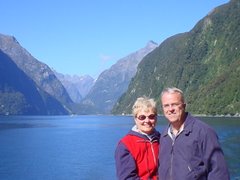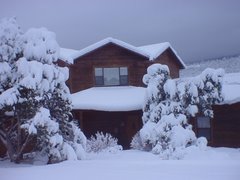Here's a map: Jerusalem at the Time of the Second Temple (which included the time of King Herod's reign).
North is to the left. The temple was in the upper rectangle, which was a leveled area called the Temple Mount. The Western Wall of the Temple Mount is also known as the Wailing Wall. Pictures to come.
Here's one of the gates into the Old City, used by both cars and people.
Here's the Dome of the Rock. It is maintained by a Jordanian agency. Access, via the covered ramp in this picture, by non-Muslims is very limited so we did not go there.
The wall in this picture, running to your right from the center of the picture, is the Western Wall. As mentioned above, it is also known as the Wailing Wall. There is a discussion in the link I just inserted of the naming issue. Also, the Dome of the Rock is within the bounds of the Temple Mount, probably built on top of remains of earlier temples (the writer of this article says it "stands on the place where Solomon’s temple once stood"), hence a contentious issue.
Here's the plaza next to the Western Wall.
On certain days of the week, including the Thursday we were there, many freshly-turned 13-year old boys have their Bar Mitzvah ceremonies here.
As Herb Geller explained to me, for years young Jewish boys study the Torah and learn how to sing the text. In this ceremony, they are being tested on it. If they make a mistake, they have to correct it.
Just behind the wall, female family members watch and throw candy at appropriate pauses in the ceremony.
Success!
A couple more scenes at the Western Wall.
A large group of African men were present. I don't know if that's typical or if there was some special occasion, or tour, that brought them here this day. If you want, you write prayers on pieces of paper and tuck them into crevices in the wall as you pray.
The gentlemen in this picture are set up for the long haul. This is in a portion of the wall access that is underground.
Quickly changing religions, here are some scenes along the Via Dolorosa that commemorates the journey Jesus took, carrying his cross, from where he was tried to Golgotha, where his crucifixion took place.
Some groups stage their own Via Dolorosa:
The present Old City is built on top of ruins of the city in Jesus' time, so today's route is not the actual place where Jesus walked. However, Irit showed us some paving rocks that had been excavated from the ruins of that period and embedded in the present walkway.
The Via Dolorosa ends at the Church of the Holy Sepulcher, said to be built on not only the site where Jesus died, but where he was buried. Here's the plaza at one entrance. There's a story about that ladder outside one window, but I've forgotten it.
A couple of interior scenes.
There were large crowds in this Church and I must admit it was a little hard to experience a feeling of awe and reverence. I'm very glad, though, that I got a chance to visit these holy sites.
We took some time for shopping. Here are some street scenes.
We finished our day looking at an area outside the Temple Mount's southern wall where excavation is ongoing. Here's a grand staircase into what once was a gate into the Temple Mount, just above the excavation area (which does not now make for an interesting picture, at least I didn't get one).
After all of this, nearing sundown, Nancy and Herb Geller and I decided to walk back to the hotel. The route took us through a swanky, modern mall (which people may have trouble interpreting 2000 years from now when it is excavated). I had come here two nights earlier looking for something to eat. A shop featuring art by David Gerstein caught the Gellers' eye, so we went in. Gerstein is a famous Israeli artist. The Gellers have a couple of Gerstein pieces. You can read more about his art than you would ever want to at this site. You can also see examples.
One of his metal "cut-outs" (probably the cheapest thing in the store), described as follows, caught my eye - I think, in hindsight, that it was the "variational freedom," which sounds statistical.
Until the late eighties - when the large body of his works called "cut-outs" appeared, along with the process of reproducing them in series of up to 295 signed and numbered copies, hand-painted in industrial paints with some variational freedom - Gerstein went through different expressive phases, yet in all of them he brought together the biographical with the local. Over the years his image reservoir grew to include local trees and birds, and his painting technique improved until it reached the formulation of handwriting, line and coloring which are uniquely his own. His images were treated again and again, his funny figures internalized their slight stammer, their innocent absurdity and their kindness, until they became more and more graphic, automatic, spontaneous, immediate, schematic, direct, with no double-lining. Merely a smiling gaze. Before the metal cut-outs with their industrial-like process of production, Gerstein created works in painted wood-cuts. He painted the first of these objects in the exact same manner as his canvases - with conventional oil paints. However, the transition to another medium and material called for relevant paints and painting techniques: super-lacquer, stencils, tapes, air brushes, etc. He tried to liberate the "statues" cut in wood from the flatness of the plywood. In order to achieve an expressive, tangible effect he covered the image's surface with a mixture of glue, sand and paint, and added acrylic paint on top of the resulting rough texture. However, it seems that even this did not satisfy him. His quest for a suitable personal language led him to metal, forcing him to give up acrylic paint and adopt industrial paint, since acrylic does not take to metal.
I didn't buy anything, but when I got back to the hotel, I decided to go back and do it. So, here's my Gerstein cow.
How could you say No to a face like that? And, because one good cow deserves another, here's another one (actually the reverse side).
I was pretty proud of my excursion into art collecting, so I was shocked, shocked to hear Susie telling people at church about his cow and laughing. Actually, she (Susie, not the cow) says she does make you smile, which is not a bad thing for art to do.
That night we had a group dinner a short walk from the hotel. Returning, one of our group spotted this intersection sign. "Take a picture. That symbolizes the cross-cultural nature of our trip."
The next morning, Friday, it was back to the Tel Aviv airport and 24 hours later I was back in Cedar Crest. Hope you enjoyed the journey.
Shalom.
Rob

































4 comments:
Great posts Dad. Amazing trip!
Thank you for the pictures, descriptions, and commentary. I've been to Israel several times since the early 80's, to visit my husband's relatives. I was curious to read a first-time visitor's take -- especially as it was a study trip. I learned a bit about the Israeli gvt. and academia, which I appreciate. Nita's friend
Just want to say how much I've enjoyed your blog, sent to me by Nita Lott. I am Rob Lott's cousin and "retired" (do we ever?) photographer. If you aren't a professional you could be.
Love your cow, so much art leaves me cold...she leaves a "warm , fuzzy, happy" glow...and a big smile.
Sharon Beaucage
I only realized days later that my cow was branded with a large E. Even more special.
Post a Comment